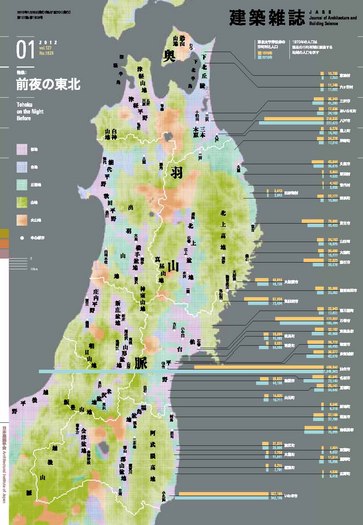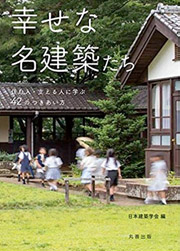本文PDFの閲覧につきましては、こちらでご確認ください。

2012-1月号 JANUARY
特集= 前夜の東北
Tohoku on the Night Before
特集前言 前夜の東北
東北の街や村を、3.11以後の衝撃的な津波の映像によって初めて知ったという人は多いだろう。
言うまでもなく東日本大震災は北関東をはじめ全国あるいは世界的にも大きな被害・損失を出しているが、とりわけ「東北」については、私たちはいささか特殊な出会い方をしたように思える。ある「地方」がいきなり国民の眼に連日晒され、なおかつそこはすでに絶望的な被災地であり、震災以前の景観や生活を知るすべもない。こうした異様な経験が、東日本大震災には含まれている。なぜそうなったのか。そして東北とはどのような場所だったのか。「東北」は、今なおさまざまな偏見や期待や政治を封じ込めた一種の符牒のように一括りに語られがちである。
それゆえ、震災が襲う直前の「東北」を、直接の被災地にかぎらず、その力強い自然環境と、その上に人間が被せた社会・産業・交通、そしてナショナル/グローバルな地政学といったものが織り成す時空間の襞のなかに、広く、丁寧に語り直さなければならない。今期編集委員会の第1号となる特集を「前夜の東北」としたのは、まずそれを前提的な作業としたいと考えたからである。
巻頭対談では、宗教学者の山折哲雄氏が日本列島を文明と災害の観点から理念的に構造化し、また気仙沼生まれの民俗学者である川島秀一氏が生き生きとした現場の地域像を語る。両者の対照的な視角が描き出す東北の立体的な見取図をうけて、第1部・第2部は、東北の地図を構成する多数のレイヤーの重層といった趣を呈することになろう。そこに建築分野のいくつかのエピソードをコラム的に交えている。
第1部「賢治のみた100年前の東北から」は、東北という空間をつくり出す自然地理的な分節構造を踏まえつつ、近世から昭和戦前期までを辿る。宮澤賢治が初めて三陸の海をみたのは最晩年の1931年。そのころの東北は帝国内の分業体制の一翼として食糧・労働力の供給地に位置付けられつつあった。三陸を襲った明治と昭和の津波(1896年、1933年)は宮澤賢治の生誕と最期の年にあたる。
第2部「前夜の東北へ」では、地方開発、漁村・漁港、交通基盤、拠点都市(仙台)、製鉄業(釜石)、原発(福島)、家族像、観光といった観点から幾筋もの戦後史が辿られる。帝国の版図を失った戦後日本における東北は、首都圏に対する後背地の役割を与えられ、次いでグローバル経済下での競争に晒されてきた。
むろん、本特集では歴史的に周縁化されてきた東北像とともにその相対化の重要性も示される。東北を見た人の眼、東北を生きた人の足も、これからへの示唆となっている。
本特集ではまた、表紙に自然地形と人口を示した中野豪雄氏作成の主題地図を、第1部のトビラには吉田初三郎が1930年代に描いた岩手・宮城・福島の太平洋側から見た鳥瞰図を、さらに第3部・資料編にはいくつかの統計地図を配した。文字によるマッピング(対談・インタビュー・寄稿)と、ビジュアルなマッピングとが、互いに補完しあうことで、本特集が生きた歴史的複合体としての「東北」に近づくための重層的な地図群となっていればと思う。
末尾になるが、本特集は歴史学・民俗学・宗教学・地理学・経済学・観光学など多くの異分野の専門家各位の協力によって成立していることを、感謝の意とともに強調しておきたい。都市計画や建築も当然ながら東北の大きな歴史地理の脈絡の交差点に描かれ、建てられてきた。震災復興と未来の社会もまたその上にしかありえない。
さて、『建築雑誌』では今後も東日本大震災をめぐるさまざまな視角からの特集を組んでいくことになるが、本号はそのなかでも特異な位置を占めることになるだろう。あえて言えば本号は、震災そのものに直接には言及しないことによって、震災の意味を浮かび上がらせる試みであり、また今後の特集のためのガイドマップとなるだろうからである。読者諸氏が本号を手に携えて東北を歩かれること、特に若い読者が自らの足で被災地の土を踏みしめ、東北、日本、世界の新たな地図を描かれることを期待する。
本号編集担当は、大沼正寛・中島直人・初田香成・近藤卓である。
青井哲人 会誌編集委員長/明治大学准教授
[目次]
| 000 | 連載 再建への意志:図面のなかの都市復興 1755年リスボン地震からの都市再建/鍬田泰子 |
| 002 | 年頭所感 日本建築学会を元気に、そしてこの世界をより暮らしやすいところに/和田章 |
| 004 | 編集委員長挨拶 建築という「学・術」をめぐるアソシエーションの展望/青井哲人 |
| 006 | 委員紹介 2012-2013『建築雑誌』編集委員会構成 |
| 008 | 連載 東日本大震災|連続ルポ1|動き出す被災地 わたしたちにできること/陶器浩一 |
| 010 | 連載 東日本大震災|連続ルポ2|仮すまいの姿 海峡を越えた移動と避難生活の現状/野村理恵 |
特集 前夜の東北
| 012 | 特集前言 前夜の東北/青井哲人 |
| 014 | 巻頭対談 名指されざるその場所─「東北」の地図を描く 山折哲雄 × 川島秀一 |
018 第1部 賢治の見た100年前の東北から
| 020 | インタビュー 東北の山と海─その自然と人文地理/米地文夫 |
| 022 | インタビュー 東北の近代─その自画像と他者像/河西英通 |
| 024 | 旅人が見た東北─菅江真澄とイザベラ・バード/鐙啓記 |
| 025 | [コラム]岩手の詩人計画者たち/中島直人 |
| 025 | [コラム]岩手・宮城・福島を訪れた3人の外国人建築家/大沼正寛 |
| 026 | 土の力と東北農山村のあゆみ/星寛治 |
| 027 | [コラム]伝統と近代化の狭間で─庄内に残る木造建築群が伝える東北の流儀/志村直愛 |
| 027 | [コラム]日本近代建築と宮城天然スレート/後藤治 |
| 028 | インタビュー 津波と村─柳田國男の足跡を追って/石井正己 |
030 第2部 前夜の東北へ─近現代の軌跡と諸相
| 032 | インタビュー 東北開発の120年/岩本由輝 |
| 034 | インタビュー 三陸漁村の戦後/富田宏 |
| 038 | 交通開拓史と近代東北の構造/三木理史 |
| 039 | 仙台における戦災復興とその今日性/渡邊慎也 |
| 040 | 「鉄のまち」釜石の盛衰/中村尚史 |
| 041 | [コラム]前川國男を受けとめた弘前の自信/北原啓司 |
| 041 | [コラム]大高正人と福島三春の街づくり/二瓶博厚 |
| 042 | むかし見た夢・これから見る夢─電力県ふくしまの過去と未来/清水修二 |
| 043 | [コラム]白井晟一の秋田の建築/安原盛彦 |
| 043 | [コラム]菊竹清訓と盛岡/若松信行 |
| 044 | 東北の家族像─世代による地域住み分けの視点から/山下祐介 |
| 045 | 東北の観光開発史─自然とともに/宮原育子 |
046 第3部 3.10の東北─データ編
| 増田聡 + 石井敏 + 坂口大洋 + 編集委員会 |
| 051 | 編集後記 大沼正寛 |
| 051 | 次号予告 2012年2月号|特集:津波のサイエンス/エンジニアリング |
| 052 | 特集を読んで 2011年11月号|特集:国・人・土のデザインⅠ アーカイブとしての東北 最良の記憶は「生活」のなかに残っている/近藤誠一 災害を記憶していくということ/足立裕司 |
Preface to the Special Issue; Tohoku on the Night Before
There will no doubt be many people whose first encounter with the towns and villages of the Tohoku region was in the devastating images of the tsunami following March 11. It is of course true that the Great East Japan Earthquake also inflicted great damage and loss on the northern part of the Kanto region, the rest of Japan, and indeed the world beyond, but in the case of the 'Tohoku' region in particular, this encounter seems to have been of a rather special nature for us. A certain 'region' is suddenly exposed to the nation's attention day after day, it is already an area of hopeless devastation, and there is no way of knowing how its landscapes and lifestyles were before the earthquake. This odd situation is part of the experience of the Great East Japan Earthquake. Why did this situation arise? And what kind of a place was Tohoku? Tohoku still tends to be used as a kind of catch-all for a whole range of prejudices, expectations and political phenomena.
For this reason, the story of Tohoku immediately before the earthquake struck, whether directly affected by it or not, needs to be retold widely and accurately, as part of the folds of space and time interwoven by the mighty natural environment and the society, industry and transport network that humans built on it, as well as national and global geopolitics. The reason why the special issue "Tohoku on the Night Before" was chosen by the editorial board as this term's first issue is that we wanted it to serve as a premise of the above task.
In the introductory dialog, the religious scholar Tetsuo Yamaori builds a conceptual picture of the Japanese archipelago through the perspectives of civilization and disaster, while the folklore scholar Shuichi Kawashima, a native of Kesennuma, presents a vivid picture of Tohoku from within the region. Following on from the three-dimensional outline of Tohoku presented in these two contrasting perspectives, Parts 1 and 2 should serve to indicate the layered nature of the multiple strata that make up the map of Tohoku. A number of episodes from the architectural field are inserted in the style of a column.
Part 1 "From the Tohoku that Kenji Saw a Hundred Years Ago" traces the period from early modern times to the pre-war era, acknowledging, as it does the segmented structure in terms of physical geography that has created the place called Tohoku. Kenji Miyazawa first set eyes on the Sanriku coastline in 1931, during the last years of his life. As part of the division of labor within the Japanese empire, the Tohoku of the time was adapting to the role imposed upon it as a region that supplied foodstuffs and labor. The tsunamis that struck the Sanriku coast in the Meiji (1896) and Showa (1933) periods coincided with the years of Kenji Miyazawa's birth and death.
Part 2: "Back to Tohoku Before the Earthquake" traces numerous strands in the region's post-war history from the perspectives of regional development, fishing villages and ports, transport infrastructure, the core city (Sendai), the steel industry (Kamaishi), nuclear power plant (Fukushima), family profiles, and tourism. In the Japan of the postwar era, which had lost its empire, Tohoku was given the role of hinterland to the Tokyo region and has subsequently been exposed to the competition of the global economy.
Of course, as well as the image of Tohoku as a historically marginalized region, this special issue underlines the importance of its relativization. The eyes of those who have seen Tohoku and the feet of those who have lived there are pointers to the future.
Also in this special issue, the front cover carries a thematic map created by Takeo Nakano indicating the region's natural topography and population; the frontispiece to Part 1 presents a bird's-eye view of Iwate, Miyagi and Fukushima prefectures from the Pacific Ocean, drawn by Hatsusaburo Yoshida in the 1930s; and Part 3 "Tohoku on March 10, 2011 (Data)" contains a number of statistical maps. Through mutually complementary verbal mapping (dialog pieces, interviews and contributed articles) and visual mapping, I hope that this special issue will serve as a layered atlas allowing us to approach the Tohoku that is a living historical complex.
Finally, I would like to emphasize, in a spirit of gratitude, that this special issue was created through the interdisciplinary collaboration of specialists from the fields of history, folklore, religious studies, geography, economics and tourism. Quite naturally, urban planning and architecture have consistently been carried out at the intersection between Tohoku's major historicogeographical contexts. The recovery from the earthquake and the society of the future, in their turn, cannot help but be founded on the same soil.
The Journal of Architecture and Building Science will continue to publish special issues presenting various perspectives on the Great East Japan Earthquake, however this issue is likely to occupy a special position among them. I venture to suggest that this is because the issue, by not making direct mention of the earthquake itself, is an attempt to reveal the earthquake's significance, and will serve as a pathfinder for future special issues. I look forward to seeing readers visit Tohoku with this issue in hand, and hope that young readers particularly will tread their own paths through the disaster-hit areas before drawing new maps of Tohoku, Japan and the world.
This issue has been edited by Masahiro Onuma, Naoto Nakajima, Kosei Hatsuda and Taku Kondo.
Akihito Aoi Chairman of the Editorial Board/Associate Professor, Meiji University
[contents]
| 000 | [Series] The Resolve to Rebuilding: City Reconstruction in Blueprint City Restoration after the 1755 Lisbon Earthquake / Yasuko Kuwata |
| 002 | [New Year's Greetings] We, Members of AIJ, Make the World a Better Place to Live / Akira Wada |
| 004 | [Greeting from the Editor in Chief] Association between Those Involved in "Knowledge-Art" in Architecture / Akihito Aoi |
| 006 | [JABS Editorial Board] 2012-2013 Editorial Board of the Journal of Architecture and Building Science |
| 008 | [Series] Great East Japan Earthquake Serial Report 1 Devastated Areas Have Just Started to Stir What We Can Do / Hirokazu Toki |
| 010 | [Series] Great East Japan Earthquake Serial Report 2 Life in Temporary Housing Relocation Across the Channel and the Current Life of Evacuees / Rie Nomura |
Special Feature
Tohoku on the Night Before
| 012 | [Preface to the Special Issue] Tohoku on the Night Before / Akihito Aoi |
| 014 | [Opening Talk]Unnamable Places ─In Tohoku, in Japan, or in the World / Tetsuo Yamaori × Shuichi Kawashima |
018 Part1 From the Tohoku that Kenji Saw a Hundred Years Ago
| 020 | [Interview] Mountains and Oceans in Tohoku ─Their Nature and Human Geography / Fumio Yonechi |
| 022 | [Interview] Tohoku's Modern Age ─Its Self-Image versus Objective Impression / Hidemichi Kawanishi |
| 024 | The Tohoku that Travelers See ─Masumi Sugae and Isabella Bird / Keiki Abumi |
| 025 | [Column] The Poet-City Planners of Iwate / Naoto Nakajima |
| 025 | [Column] Three Foreign Architects Who Visited Iwate, Miyagi, and Fukushima / Masahiro Onuma |
| 026 | The Power of Soil and the History of Mountain Farm Villages in Tohoku / Kanji Hoshi |
| 027 | [Column] Between Tradition and Modernization ─The Wooden Buildings that Remain in the Shonai Area Convey the Tohoku Style / Naoyoshi Shimura |
| 027 | [Column] Modern Japanese Architecture and Miyagi Natural Slate / Osamu Goto |
| 028 | [Interview] Tsunami and Villages Following the Footprints of Kunio Yanagita / Masami Ishii |
030 Part2 Back to Tohoku Before the Earthquake
─Tracks and Aspects of Modern-Contemporary Days
| 032 | [Interview] A 120-Year History of Tohoku Development / Yoshiteru Iwamoto |
| 034 | [Interview] Sanriku Fishing Villages Postwar / Hiroshi Tomita |
| 038 | Transport-Pioneer History and the Structure of Modern Tohoku / Masafumi Miki |
| 039 | Postwar Recovery and Its Current Sense in Sendai / Shinya Watanabe |
| 040 | The Rise and Fall of Kamaishi, "the Iron City" / Naofumi Nakamura |
| 041 | [Column] The Self-Confidence of Hirosaki in Accepting Kunio Maekawa / Keiji Kitahara |
| 041 | [Column] Masato Otaka and the Establishment of Fukushima Miharu / Hiroatsu Nihei |
| 042 | Dream in the Past and Dream in the Future ─Fukushima Prefecture as a Generator for the Capital / Shuji Shimizu |
| 043 | [Column] Seiichi Shirai Architecture in Akita / Morihiko Yasuhara |
| 043 | [Column] Kiyonori Kikutake and Morioka / Nobuyuki Wakamatsu |
| 044 | Image of the Family in Tohoku─From the Perspective of Separating Living Areas by Generation / Yusuke Yamashita |
| 045 | History of Sightseeing Development Along with Nature / Ikuko Miyahara |
046 Part3 Tohoku on March 10, 2011 Data
| Satoshi Masuda + Satoshi Ishii + Taiyo Sakaguchi + Editorial Board |
| 051 | [Editor's Postscript] Masahiro Onuma |
| 051 | [Preview of Coming Issue] 2012, February|Tsunami Science/Engineering |
| 052 | [Reviews of Previous Issue] 2011, November|Designing Nation, People, and Land: Vol. I Tohoku as Archives Best Memories Remain Part of Life / Seiichi Kondo What It Means to Remember the Catastrophe / Hiroshi Adachi |




 『幸せな名建築たち 住む人・支える人に学ぶ42のつきあい方』
『幸せな名建築たち 住む人・支える人に学ぶ42のつきあい方』





